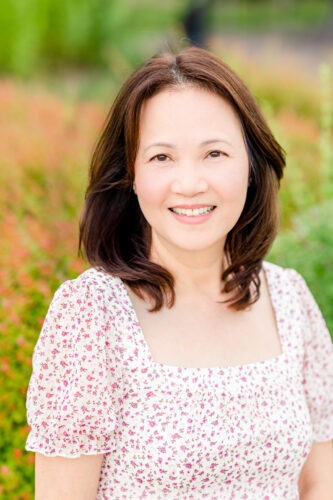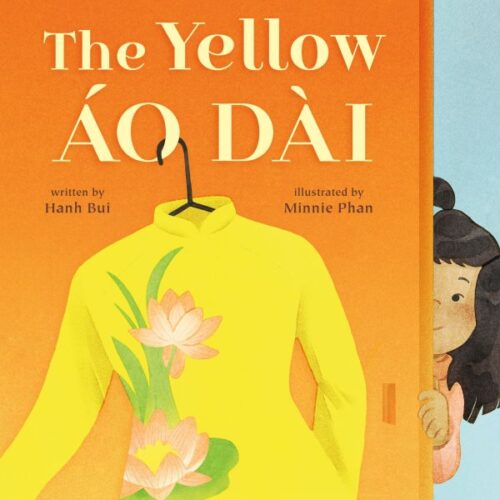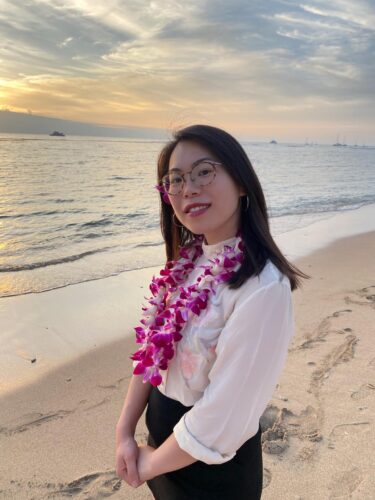The Yellow Áo Dài : A Talk with Hanh Bui and Minnie Phan
Just back in July of this year I had the chance to host author Hanh Bui in a guest post entitled Libraries and Librarians Enrich Lives Far Beyond Books (a sentiment of which I’m rather fond). Honestly, it seemed only natural that when Hanh’s debut picture book came out I’d get a chance to talk to her about it. Today, however, it’s even better than that. We’re discussing her upcoming Spring 2023 title The Yellow Áo Dài not just with her but with illustrator Minnie Phan as well!
Here’s a rundown of the story:
Naliah is excited to perform a traditional Vietnamese Fan Dance at her school’s International Day. When she finds that her special áo dài no longer fits right, she goes to her mom’s closet to find another.
She puts on a pretty yellow one—only to accidentally rip it while practicing her dance. She’s horrified to discover that this was a very special áo dài that her grandmother had worn to dance at the Mid-Autumn Festival in Vietnam.
But with a little help from her mom’s sewing kit and her grandmother’s loving legacy, Naliah learns not only how to mend the yellow áo dài but also how to believe in herself and make it her own.
And here, as promised, are the creators themselves:
Betsy Bird: Hanh, I’d love to start with you. Can you tell me just a little bit about how this book even came to be? Is there some truth behind the story? Any autobiographical details we should know about?
ADVERTISEMENT
ADVERTISEMENT

Hanh Bui:The Yellow Áo Dài is inspired by my daughter and her grandmother, my mother-in-law. When my daughter was six-years-old, she attended Grandparents’ Day at her school. She felt sad and different from her classmates because she didn’t have grandparents. One day she discovered the áo dàis in my closet that belonged to her beloved grandmother who passed away when my daughter was a baby. She asked if she could try on the yellow one, her favorite color. She was much too small for it. We negotiated back and forth and finally agreed she could wear it when she turns sixteen. I explained to my daughter that each áo dài carries special memories of an event when her grandmother wore it. My daughter was overjoyed to learn that she and her grandmother both love yellow, the color of happiness. Her favorite story is of her grandmother being crowned the Mid-Autumn princess when she was a school girl in Vietnam. In this book, I wanted to also honor my mother-in-law’s resourceful sewing skills. She made and mended clothing for herself and her family. My mother-in-law’s special áo dàis and our family stories helped my daughter to feel connected with her grandmother. I knew this was a story seed for a book celebrating family ties and our Vietnamese heritage.
BB: And Minnie, how did you get involved with the project? What was it that intrigued you about it? What did you feel you could bring to the page?
Minnie Phan: I was brought onto the project by my fabulous agent, Andrea Morrison at Writers House. When I was sent Hanh’s manuscript, I leapt at the opportunity to be the illustrator. A book like The Yellow Áo Dài did not exist when I was a child. I was thrilled to be part of a new generation of picture books.
I felt I could bring to the page a shared love of Vietnamese culture and identity. The characters would not be caricatures; they’d be informed by an authentic Vietnamese perspective.
Also, it was not just what I could bring to the page, but what our team could build together. Shout out to Melissa Vuong, our book designer, who was phenomenal and served as an unofficial sensitivity reader. This book is Vietnamese AF!

BB: Hanh, one of the things I like so much about the book is that it’s a contemporary story about a Vietnamese-America kid that focuses on the present day. Could you talk a little bit about visibility in picture books and the importance of having these stories told?
HB: Representation in children’s literature is important in order for us to celebrate the experiences of families from all different cultures. In doing so, we can show more children that they matter and foster empathy for others. As a child, I didn’t see myself between the pages of books. Even now, there are few books that portray the experiences of today’s Vietnamese Americans with authenticity. I want to normalize not only our refugee and immigrant experiences, but to also share our family stories. I believe that stories like mine will help readers of all ages appreciate the many layers of our experiences as Vietnamese Americans. It is my hope for all children to see themselves in books.
BB: Minnie, one of my favorite moments in the story is when Nailah realizes she’s ripped her mother’s áo dài, and shoves it back into the closet with this mixed expression of guilt and desperation. I think there’s humor to the book that deserves to be called out. Could you tell us a bit about your artistic influences and the picture books that have served as an inspiration to you?
MP: Part of my job as an illustrator is to add to the text in a visual way. What I appreciate most about Hanh’s story is how it subversively pushes against harmful Asian stereotypes. Western society tends to focus on negative Asian mother-daughter relationships. However, in Hanh’s story there are no tiger moms. Instead, there is vulnerability, forgiveness, and love. I wanted to match Hanh’s literary tenderness with my own visual playfulness, further humanizing her characters and how Asians are depicted. Humor serves as a reminder that yes, everyone is simply human. Asian people are as clumsy as we are competent; playful as we are driven.
Aesthetically, books that influenced me include I Am Golden by Eva Chen and Sophie Diao, Paper Son by Julie Leung and Chris Sasaki, and, without fail, everything illustrated and/or written by LeUyen Pham.
BB: Hanh, you’ve some great backmatter in this book, talking about your own family history as well as providing a Glossary (I particularly like the part about sniff kissing). I’m actually really interested in the choices authors make when they create backmatter. How did you select the photographs? How did you decide which stories to tell? And did you have any help with the Glossary or were you clear on the terms from the start?
HB: I’m honored to share my mother-in-law’s fond memories of life as a young schoolgirl and being crowned Mid-Autumn princess. The picture I selected is of her as a young girl in the meadows of Vietnam. I am bilingual and grew up speaking both Vietnamese and English. Therefore, I did not need help with the glossary. I was intentional with my decisions to choose Vietnamese words and phrases that I wanted to introduce to our readers. Sniff kisses is one of my favorite traditions as a child and mother. When I was a little girl, I received sniff kisses from my grandparents. As a mom, I give sniff kisses to my children and am grateful for their sweet sniff kisses too. This loving expression of affection is a nod to our Vietnamese roots. I hope that after reading this book, children and the adults in their lives will embrace sniff kisses.
BB: Minnie, could you talk a little bit about the research you did to prepare for this book?

Photo by Kathy Phan
MP: My illustrations are informed by real life and I had a blast scrolling through photos of butterflies, áo dài, Mid-Autumn in Vietnam, and student dance videos from across the globe. Actually, the fan dances in the book directly reference various Vietnamese Student Association performances on Youtube.
Additionally, I revisited photos from my first solo trip to Vietnam. It was exciting to discover details long ignored: plants growing behind buildings, palm trees dotting the skyline, tin roofs scattered across country fields.
ADVERTISEMENT
ADVERTISEMENT
Lastly, due to the complicated nature of growing up Asian American, parts of my childhood simply existed: traditional dresses, foods, ceremonies. I was not often given context for why we did something or where it came from. Researching The Yellow Áo Dài allowed me to bridge cultural gaps and learn about many foundational elements of my life. I’m grateful to this project and Hanh for bringing me closer to my Vietnamese heritage.
BB: Finally, what are you both working on next?
HB: Ánh’s New Word, a picture book based on my refugee experiences, is slated for 2024 with Feiwel and Friends. I also have several other picture books out on submission with my agent. I’m currently working on a middle grade anthology honoring helpers and the important work they do. I’m excited to collaborate with an amazing line up of kindhearted authors and illustrators as we bring our voices together to make a difference.
MP: Shh, this one is under wraps but…I’m illustrating a picture book about climate change with a Pulitzer prize winning author, set to be published by minedition in 2024. Stay tuned!
I gotta say, interviews are great, but it’s awfully satisfying to hear when creative people have even more irons in the fire. I want to thank Hanh Bui and Minnie Phan for taking the time to answer my questions today. The Yellow Áo Dài hits shelves everywhere April 25, 2023. Look for it then!
Filed under: Uncategorized
About Betsy Bird
Betsy Bird is currently the Collection Development Manager of the Evanston Public Library system and a former Materials Specialist for New York Public Library. She has served on Newbery, written for Horn Book, and has done other lovely little things that she'd love to tell you about but that she's sure you'd find more interesting to hear of in person. Her opinions are her own and do not reflect those of EPL, SLJ, or any of the other acronyms you might be able to name. Follow her on Twitter: @fuseeight.
ADVERTISEMENT
ADVERTISEMENT
SLJ Blog Network
Should I make it holographic? Let’s make it holographic: a JUST ONE WAVE preorder gift for you
Magda, Intergalactic Chef: The Big Tournament | Exclusive Preview
Fifteen early Mock Newbery 2026 Contenders
When Book Bans are a Form of Discrimination, What is the Path to Justice?
RA Tool of the Week: Inside Out Inspired Emotions, but Make it YA Books
ADVERTISEMENT







